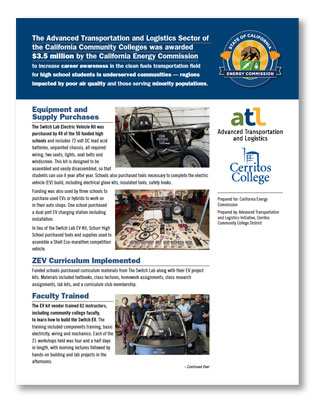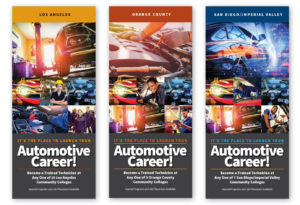
 Clean transportation is a priority in Southern California, and students around the state are stepping up to the plate to work on the next generation of low- and zero-emission vehicles.
Clean transportation is a priority in Southern California, and students around the state are stepping up to the plate to work on the next generation of low- and zero-emission vehicles.
California Energy Commissioner Janea A. Scott and staff visited four Southern California high schools October 16 and 17 to meet students who will soon be building a Switch Electric Vehicle purchased for each school through a grant from the Energy Commission. The project is a collaboration between the high schools and the Cerritos Community College District’s Advanced Transportation Technology and Energy Center.
The Energy Commission provided funding to 12 high schools across the state to increase career awareness in the clean fuels transportation field –focusing on schools serving underserved communities, minority groups, and regions impacted by poor air quality.
“California is transitioning to low-carbon fuels and zero- and near zero- emission transportation in order to meet its ambitious climate change goals and federal air quality standards. Ensuring a well-trained workforce to develop, deploy, and shepherd this transition is critical,” said Janea A. Scott, lead commissioner on transportation with the Energy Commission.
 Scott and Jannet Malig, Statewide Director of the Advanced Transportation and Logistics Sector of the California Community Colleges, visited the following schools:
Scott and Jannet Malig, Statewide Director of the Advanced Transportation and Logistics Sector of the California Community Colleges, visited the following schools:
- Artesia High School, Lakewood
- Mira Mesa High School, San Diego
- Schurr High School, Montebello
- Valley High School, Santa Ana
Each visit included a facility tour and presentations by teachers, students, and administrators to showcase achievements inside and outside of the classroom.
The automotive field, particularly hybrid and alternative fuel vehicles, provides stable, high-paying jobs to students from a variety of backgrounds. Because of this funding and the dedication of instructors, administrators and other partners, the schools are creating pathways from high school to community college to the workforce.
“I am inspired by the leadership the students are showing, the creativity and innovation,” Scott said. “Everything the students are learning in this space will guide us into the future of cleaner transportation. We can’t do it without the students’ engagement and enthusiasm, or the educators who are providing students with this meaningful, hands on experience.”
Artesia High School
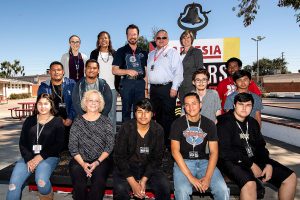 Artesia High School serves a community of approximately 85,000, composed primarily of middle to lower socioeconomic status families. About 75 percent of the school’s students are economically disadvantaged.
Artesia High School serves a community of approximately 85,000, composed primarily of middle to lower socioeconomic status families. About 75 percent of the school’s students are economically disadvantaged.
The school utilizes block scheduling to maximize the time that students spend on Career Technical Education (CTE) courses like automotive repair. The school has also partnered with Snap-on to provide discounts to students who purchase their own tools.
“Having a block schedule has allowed AP kids and kids that usually wouldn’t be in a CTE program to experiment and take the CTE classes, which has been pretty neat for them,” Principal Sergio Garcia said. “We looked at the businesses along the 91 Corridor to make sure our pathways were going to be a fit.”
The Switch Electric Vehicle purchased through the Energy Commission grant will be incorporated into the Automotive Alternative Fuels III class. Automotive instructor Marty Supple said the vehicle would provide students with invaluable hands-on experience.
“Everybody has to learn a skill,” Supple said. “It’s a dirty job sometimes, but engineers spend millions to develop new technology, and you need to fix it.”
Mira Mesa High School
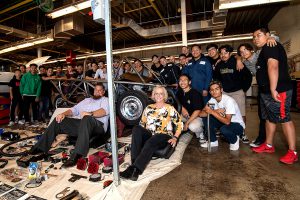 Mira Mesa High School serves nearly 2,500 students. More than half of its student body is eligible for free or reduced-price lunches, and nearly 10 percent have a disability.
Mira Mesa High School serves nearly 2,500 students. More than half of its student body is eligible for free or reduced-price lunches, and nearly 10 percent have a disability.
The school has already received its Switch electric vehicle and had all of the parts unpacked and ready for painting during the Energy Commission visit. But what made this visit unique, is that the students didn’t know about it in advance.
After a tour of the campus and CTE programs, instructor Ryan Monroe and district colleagues introduced the Energy Commission visitors to the class and announced to the students that Mira Mesa was the only high school chosen in the San Diego area to receive this grant. Monroe explained that they would be learning about electric vehicles by building the Switch Lab car.
Monroe also teaches at San Diego Miramar College, and is hopeful that Mira Mesa students will funnel into the college program after graduating.
Schurr High School
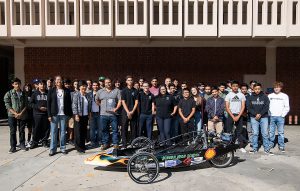 Schurr High School serves about 2,800 students, nearly 90 percent of whom are Hispanic. More than 75 percent of the school’s students qualify for free or reduced-price lunch.
Schurr High School serves about 2,800 students, nearly 90 percent of whom are Hispanic. More than 75 percent of the school’s students qualify for free or reduced-price lunch.
Under automotive instructor Armando Hernandez’s direction, the school has participated in the Shell Eco-Marathon since 2008. Their competition vehicle this year was powered by liquid petroleum gas and got 227 mpg in the competition.
Schurr High School’s team placed 17th in 2018 after facing competition from colleges and universities across the country.
“Some participants from other schools are doctoral students, and others are working at companies as engineers,” Hernandez said. “I’m extremely proud of our team.”
Valley High School
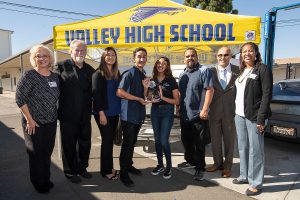
Teachers in Valley High School’s Automotive Transportation & Logistics Academy, part of Santa Ana Unified School District (SAUSD), are integrating an electric vehicle unit into their Career and Technical Education (CTE) programs to give students hands-on experience with and exposure to this growing field, with the goal of students matriculating into their local community college programs for more advanced skills training.
Nearly all of Valley High School’s students are eligible for free or reduced-price lunches, and many are first-generation high school graduates.
The Automotive Academy at Valley High School, supported by High School Inc., is one of only three high school automotive programs in Orange County to be certified through the National Automotive Technician Education Foundation (NATEF). In addition, Auto Academy students are able to earn Automotive Service Excellence (ASE) certifications during high school, which are an industry requirement for technicians.
“Academies represent what is actually happening in the industry today, not what we think is going to happen,” said Mark McLoughlin, President of High School Inc.
The academy model is possible because of a collaboration between Valley High School, Santa Ana Unified School District, SAUSD Career and Technical Education and High School Inc.
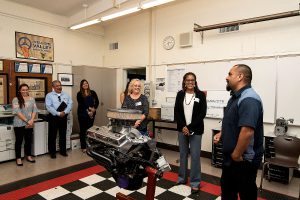 Valley High School has articulation agreements with several community colleges throughout Orange County: Coastline College, Golden West College, Irvine Valley College, Orange Coast College, Santa Ana College, and Santiago Canyon College.
Valley High School has articulation agreements with several community colleges throughout Orange County: Coastline College, Golden West College, Irvine Valley College, Orange Coast College, Santa Ana College, and Santiago Canyon College.
The academy also receives support and donations from local dealers and other businesses. Automotive instructor Saul Garcia said the program has received lifts, an alignment machine and Snap On toolboxes with tools from business partners.
One dealer in particular, South Coast Audi, has hired 12 of the program’s students. The dealer support motivates students even more to succeed. “They treat our kids like family,” Garcia said.
While most academy students are male, Garcia said there are about 20 females in the academy. “We put them on one team and they rotate tires and do coolant flushes…they are getting hands-on experience.”


